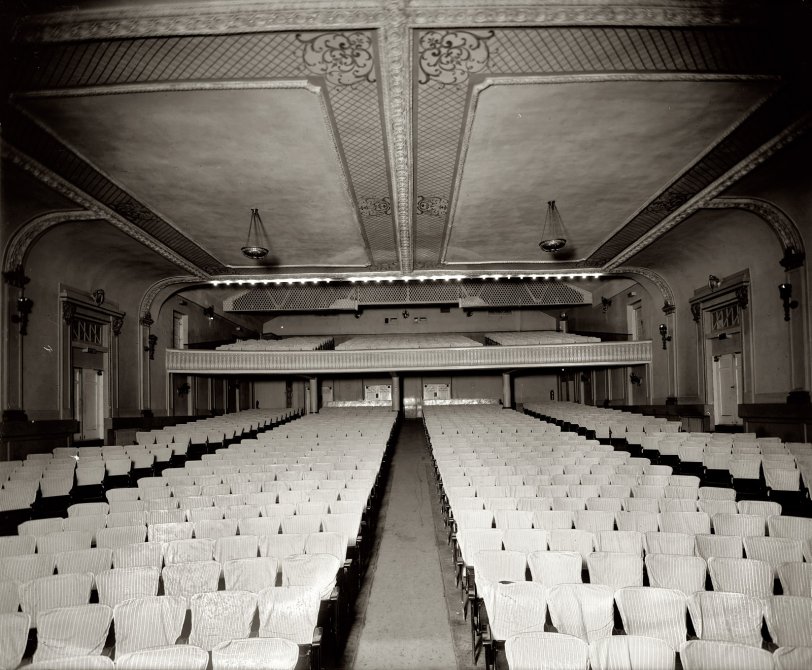


Framed or unframed, desk size to sofa size, printed by us in Arizona and Alabama since 2007. Explore now.
Shorpy is funded by you. Patreon contributors get an ad-free experience.
Learn more.

- Freeze Frame
- Texas Flyer wanted
- Just a Year Too Soon
- WWII -- Replacing men with women at the railroad crossing.
- Yes, Icing
- You kids drive me nuts!
- NOT An Easy Job
- I wonder
- Just add window boxes
- Icing Platform?
- Indiana Harbor Belt abides
- Freezing haze
- Corrections (for those who care)
- C&NW at Nelson
- Fallen Flags
- A dangerous job made worse
- Water Stop
- Passenger trains have right of way over freights?
- Coal
- Never ceases to amaze me.
- Still chuggin' (in model form)
- Great shot
- Westerly Breeze
- For the men, a trapeze
- Tickled
- Sense of loneliness ...
- 2 cents
- Charm City
- What an Outrage
- Brighton Park
Print Emporium
Movie Palace: 1920

Washington circa 1920. "Crandall's Savoy, interior." View full size. National Photo Company Collection glass negative, Library of Congress.
Flash exposure
This was obviously lit with a flashpot. I find it amazing that the flash lit the theater all the way to the back wall and yet the first few rows of seats aren't overexposed. Either this emulsion had better exposure latitude than most modern film (and digital cameras) or the image was artfully adjusted when making the print.
[There is no print. These are all made from negatives, which are digitally inverted to give the positive images seen here. - Dave]
Segregated seating
Regarding the question below, I don't know this theater's policy, but in days gone by there was a rather unfortunate term involving the "N' word commonly used for the upper reaches of the balcony in theaters that were so segregated. A Google with relevant words will find it.
Savoy Theater
Robert K. Headley's Motion Picture Exhibition in Washington, D.C. has an extensive entry for this theater. In its day, it was the largest motion picture theater in Washington outside of downtown. For a time, there was an open-air theater known as the Savoy Park or Savoy Garden behind the Savoy.
A 2/8 Moller organ was installed in 1920; the interior was remodelled again in 1927; the facade was redone in 1942 in art deco.
The Savoy was eventually eclipsed by the nearby Tivoli at 3215 14th Street. Damaged in the 1968 riots, the Savoy closed in 1968 and was demolished in 1971.
Just Curious
Were the theatres in DC racially segregated at this time? If so, would there be a section for African-Americans in a theatre of this caliber?
The Savoy
Washington Post, Apr 30, 1916
It was announced last week that the Savoy Theater, of Washington's largest motion picture houses, had been sold by the Savoy Theater company to Harry M. Crandall for a cash consideration of $75,000, as stated. Thus is completed the chain of four Crandall theaters, the other three of which are Crandall's at the southeast corner of Ninth and E streets northwest, the Apollo, and the Avenue Grand, recently acquired. The deal was negotiated by Moore & Hill, Inc.
The Savoy stands at 3030 Fourteenth street northwest. Adjoining it is a garden used in the summer as an open moving picture place. Together they represent one of the biggest local enterprises along this line. Furthermore, the seating capacity of the Savoy will be shortly increased from 1,000 to 1,400, as Mr. Crandall announces he will put into effect extensive renovation plans prepared for the former owners by B. Stanley Simmons, architect. This includes an addition of 30 feet to the width of the structure and a change in style of the front, with the marquise and a Spanish effect above. The base is to be of stone and the upper walls of red rough texture bricks, with terra cotta pilasters. A large gallery is to be provided and also a series of mezzanine boxes.
The Savoy was put up some years ago and is modern in every respect. Mr Crandall will take possession May 1, it is said. The improvements will cost in the neighborhood of $10,000.
By means of his "chain" system, Mr. Crandall will be enabled to secure the choicest films for showing in his houses.
Some more history of the Savoy.
























On Shorpy:
Today’s Top 5